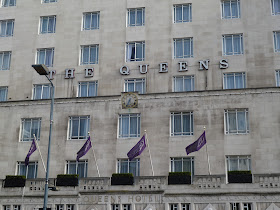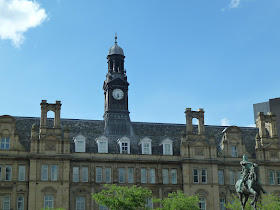The first stop is Holy Trinity church on Boar Lane. Originally built in 1722-27, the tower on which the clock sits is a later addition from 1839 after the original tower blew down.
The backdrop to the church is a construction site for another extension to Leeds renewed retail experience.
Not far from Holy Trinity is what was once the Griffin Hotel, its clock being a bit of a giveaway to its former identity. It is not readily apparent what the building now is - probably a mixture of uses. The clock is another product of Potts of Leeds from 1877.
Moving westwards along Boar Lane leads into Wellington Street. Here you can find the Queen's Hotel, built in 1937 by the LMS railway (the hotel fronts onto the railway station).
The clock is rather nice, but somewhat lost in the large facade.
Opposite the hotel is City Square, the location for the General Post Office building of 1896.
The statue is of the Black Prince, who has no connection whatsoever with Leeds, but was presented by the Mayor in 1899 as enshrining the chivalric ideal. Like that mayor's style!
Moving west on Wellington Street is the imaginatively named Wellington House. This is the home of Metro (or more properly the West Yorkshire Integrated Transport Authority), and also of this clock:
Further down Wellington Street is the much newer Regent House (indeed the name could be read as Recent House at first glance). It is always good to see new developments incorporating clocks, and this is a good example rather than the GRP tower add-ons that many new buildings go in for as an attempt to show tradition and cultural sensitivity. Okay, so I am not going to vouch for the authenticity of the materials used here, but full marks to this developer anyway.
Heading back to the city centre, it is time to pay a visit to the railway station. This is the 1938 concourse with its very simple but very striking clock. Elsewhere on the large station the only other timekeeping is of the electronic variety. Efficient for the passenger, but rather lacking in style or romanticism.
And behind the station is a multi-storey car park with this large clock. Not sure why it needs a clock, but hey why complain?
Right over now to the east of the city centre, and the Corn Exchange. This elliptical building was completed in 1862. The exterior merges into its surroundings, and has this fairly standard clock (you will be recognising the pattern of the dial face by now).
Inside is rather more grand, and the design makes most of the elliptical shape. The impressive clock is almost lost within the magnificent of the roof and general interior design.
On now to St Peters, the parish church, of 1844. Another church, another clock.
And finally, the Time Ball Building on Briggate. Originally two C17 houses, the facade was completely re-modelled and a time ball (falling at 1 pm) and this clock were added in 1910.
A second clock has this figure of Father Time, and the motto tempus fugit. However in this case there is not a lot of fugitting of the tempus going on as both clocks are stopped. In fact, I think that the real reason that this is called the Time Ball building is that the time it shows is a load of ....... ! But nice clocks though.



















No comments:
Post a Comment